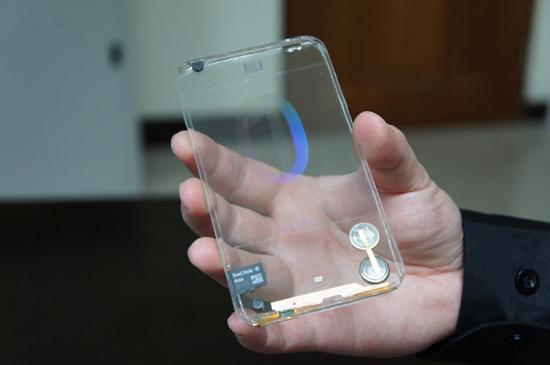
A smartphone's display is one of the most important features of a new device, with things like screen size, display tech and resolution being some of the first details of a handset that people want to know about. A Taiwanese company known as Polytron Technologies has created a new prototype phone whose display is sure to garner attention, but not for things like size or resolution. As noted by Mobile Geeks and The Verge, the firm has crafted a transparent phone prototype that uses Switchable Glass tech, which is an OLED display that utilizes liquid crystal molecules to actually display things on the screen. When the display is off, the molecules are scattered and give off a white, cloudy look. Once an electric current flows through them, though, they line up and can form text and images.
As you can see in the image above, there are still a few parts of the prototype unit that aren't transparent. We can see a microSD card (a micro-SIM card slot would be placed directly above it), a microphone and batteries. Polytron expects to cover that part of the device with an opaque glass so that users don't have to stare directly at the unit's internals. There's also no actual software running on this prototype, as it's just meant to shown off Polytron's hardware. The final hardware will feature touch panels on both its front and back.
So when might transparent devices like this become more than a prototype and actually enter production? Polytron general manager Sam Yu recently told Macworld that he expects that consumers will see transparent hardware "near the end of 2013." Yu went on to tease to The Verge that his company is engaged in serious talks with unnamed "major smartphone makers" in countries like the U.S. and South Korea. Polytron doesn't plan to stop at smartphones, either, as Yu said that the firm plans to introduce a prototype tablet with a transparent display in the coming weeks.
Polytron certainly isn't the first company to attempt to bring transparent phones to market, as Sony Ericsson actually introduced a handset known as the Xperia Pureness in 2009, though that device's display is a bit smaller than the one on Polytron's prototype. Whether or not phones with Polytron's tech would be more successful with consumers than the Xperia Pureness is a mystery. There would almost certainly be some people that'd purchase the devices just because it's transparent, but Polytron and the manufacturer(s) would likely need to come up with reasons as to why potential buyers should select the transparent smartphone over a more traditional handset.
What do you all think of the idea of a transparent smartphone? Do you think that a phone with a see-through display is something that you'd consider opening your wallet for? To help you make a decision, you can check out Mobile Geeks' hands-on with Polytron's transparent prototype below.
Via Mobile Geeks, The Verge, Macworld